A restaurant-quality chicken and gravy recipe takes just 20 minutes to prepare – sounds unbelievable, right?
This family-favorite comfort dish needs only simple pantry staples and 1 pound of chicken breasts. Your busy weeknight dinners and cozy weekend meals will transform with our simple chicken and gravy recipe that delivers rich, homestyle flavors effortlessly.
A few key techniques and the perfect balance of ingredients make all the difference. We’ll guide you to achieve the ideal 165°F internal temperature and create perfectly smooth gravy from pan drippings. Your new go-to comfort meal awaits as you become skilled at this classic dish!
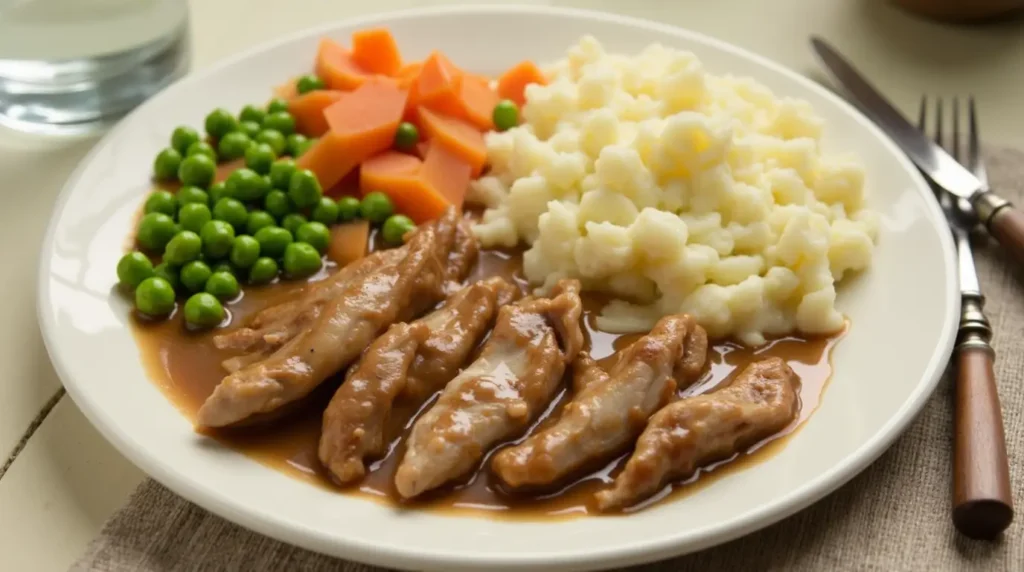
Table of Contents
Essential Ingredients for Perfect Chicken and Gravy
The secret to perfect chicken and gravy lies in choosing quality ingredients. Your choice of chicken parts plays a vital role in building rich flavors.
Best cuts of chicken to use
Boneless, skinless chicken breasts are the foundations for a classic chicken and gravy recipe. Boneless chicken thighs give you a stronger flavor profile and stay tender as they cook. You’ll get the richest gravy base by using chicken bones, wings, and giblets.
Must-have pantry items
These ingredients form the core of any chicken and gravy recipe:
- Butter: ½ cup unsalted butter gives richness and creates the base
- All-purpose flour: ½ cup for thickening and binding
- Chicken stock: 1 quart cold stock or broth
- Heavy cream: ⅓ cup for velvety smoothness
- Basic seasonings: Salt, white pepper, and a pinch of cayenne
Optional flavor enhancers
Your gravy’s taste profile can reach new heights with extra ingredients. Chicken drippings from roasted chicken bring deeper flavors. You can add depth with:
Fresh herbs like thyme, sage, or rosemary add wonderful aromatic notes. A splash of sherry or cognac creates complexity. Roasted garlic or sautéed mushrooms give earthy undertones. You can make it creamier by stirring in ½ cup sour cream at the end.
Flour and cornstarch together create the perfect texture that avoids the shiny gumminess you often see in single-thickener gravies. This combination results in a smoother, silkier consistency while keeping the rich, creamy qualities of traditional gravy.
Step-by-Step Cooking Process
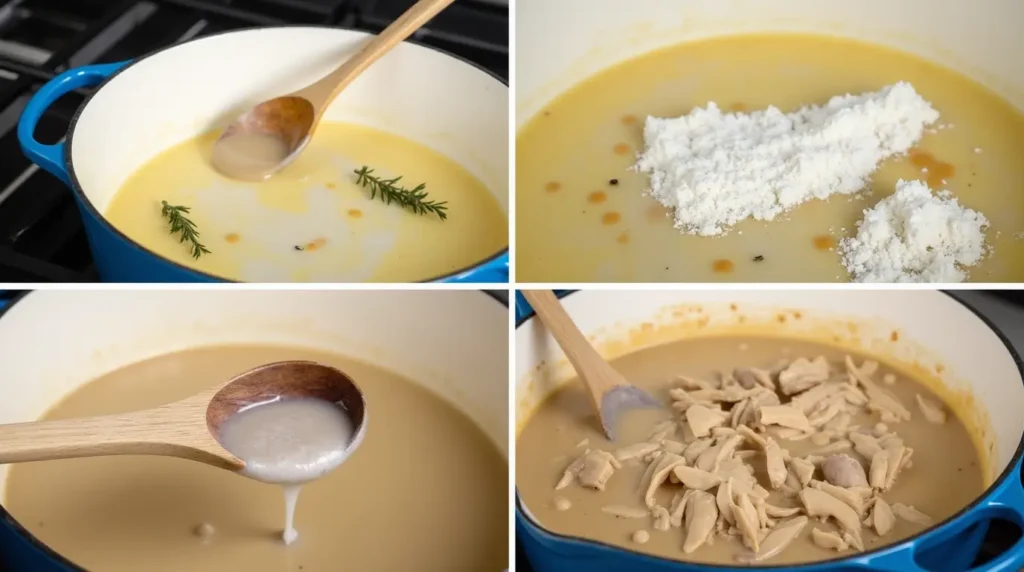
Let’s become skilled at making the perfect chicken and gravy by focusing on specific techniques and timing. Here’s a detailed guide that will reshape the scene of simple ingredients into an amazing dish.
Preparing the chicken
Start by coating the chicken with vegetable oil and season it really well. Put a large skillet over medium-high heat and add butter with oil. Next, sear the chicken skin-side down until it browns nicely, which takes about 3-5 minutes per side. After searing, set the chicken aside while you work on the gravy base.
Making the roux base
A perfect roux is the foundation of exceptional Chicken and Gravy. Melt butter in a saucepan over medium-low heat and slowly whisk in flour. You’ll need 2 tablespoons each of fat and flour for every cup of liquid to get the right thickness. Keep stirring the mixture until it turns light golden and gives off a nutty smell, usually around 10-12 minutes.
Adding liquids and seasonings
Here’s the quickest way to add liquid: Start with ½ cup of cold stock or drippings, and whisk non-stop to avoid lumps. Then pour in the remaining stock gradually, about 2 cups at a time. To improve flavor, add pan drippings after they settle and you’ve removed extra fat.
Achieving ideal consistency
Your gravy should coat the back of a spoon – what chefs refer to as “nappant”. Let it simmer for 5-8 minutes with regular whisking. The gravy’s too thick? Just add more broth gradually. If it stays thin after 10 minutes of simmering, mix 1 teaspoon cornstarch with 1 tablespoon water to make a slurry.
These steps will give you professional results:
- Never stop whisking when adding liquid
- Keep the heat at medium-low throughout
- Give enough time for flavors to develop while simmering
- Wait to adjust seasoning until you get the right consistency
- Strain the gravy for the smoothest result
Your Chicken and Gravy will get slightly thicker as it cools, so make it a bit thinner than you want the final result. This approach will give you smooth, lump-free gravy that pairs perfectly with your chicken.
Home Chefs’ Secret Techniques
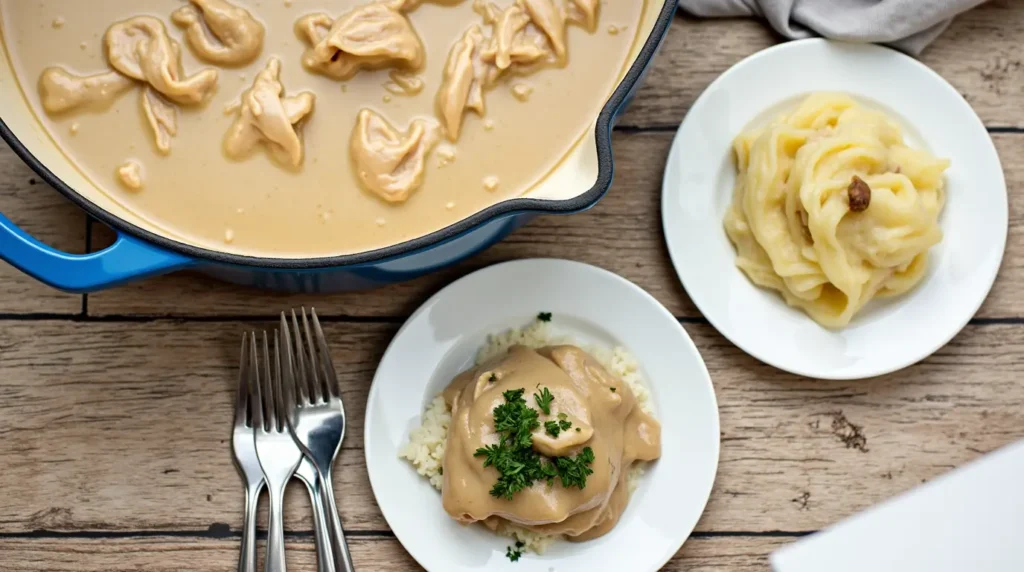
Professional chefs use precise techniques to make perfect Chicken and Gravy. These methods will give you restaurant-quality sauce that tastes exceptional.
Temperature control tips
Temperature management is the key to silky-smooth gravy. Professional chefs start with hot liquid whenever they can. This reduces the time needed to thicken the gravy and minimizes lumps. You should spread the gravy in an unheated skillet instead of a small pot when reheating. A larger surface area helps control temperature better and thickens the gravy more evenly.
Medium-low heat works best throughout the cooking process. Take the pan off the heat before adding new liquids to stop lumps from forming. The gravy will thicken naturally once it starts to simmer again.
Stirring methods
Your whisking technique is vital – keep the mixture moving to prevent lumps and cook everything evenly. Add liquids slowly while whisking non-stop. Begin with ¼ cup portions and increase the amount as the mixture becomes smoother.
Top chefs use these professional finishing touches:
- Monter au beurre: Swirl cold unsalted butter into the finished gravy off heat to get a velvety finish
- Slurry technique: Mix cornstarch with cold water in a sealed container and shake before adding to boiling gravy
- Progressive thickening: Let the gravy cool slightly after removing from heat as it thickens naturally
Note that these chef-approved methods work best to adjust consistency. Add warm broth gradually while whisking to thin the Chicken and Gravy. To thicken it, mix 1 teaspoon cornstarch with 1 tablespoon water for each cup of gravy.
Proper temperature control combined with expert stirring techniques creates lump-free, well-seasoned, and smooth gravy. These professional methods will give you restaurant-quality results every time you make Chicken and Gravy.
Common Mistakes to Avoid
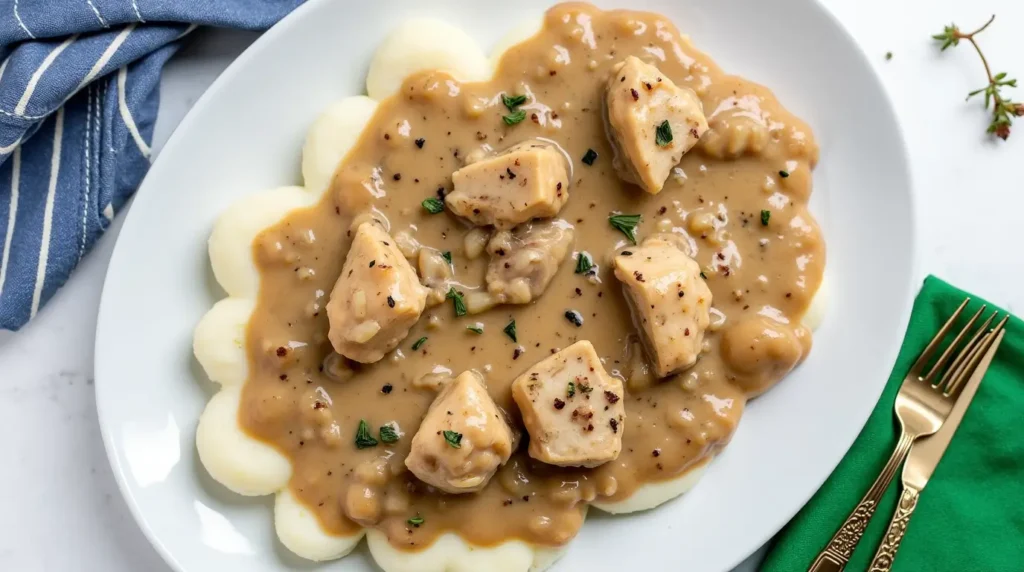
Chicken and gravy can challenge even experienced home chefs. Learning about common mistakes will help you avoid disappointing results and make perfect Chicken and Gravy every time.
Wrong flour-to-liquid ratio
The right ratio of flour to liquid is the foundation of smooth gravy. You’ll need 1.5 tablespoons each of flour and fat for every cup of liquid. Some recipes suggest 2 tablespoons of each for a thicker consistency. Lumps will form if you add flour directly to hot stock because starch granules swell unevenly. This happens whatever whisking technique you use.
Here are proven solutions to fix ratio problems:
- Mix flour with room-temperature stock before adding to hot liquid
- Create a smooth paste with equal parts flour and butter
- Use instant flour (like Wondra) for easier dissolution
- Strain through a fine-mesh sieve if lumps persist
Temperature issues
We learned that temperature control affects gravy’s consistency and texture. Separation occurs when you add liquid too quickly to hot roux. Your Chicken and Gravy will thicken unevenly if you add cold stock to boiling gravy. Keep a steady simmer over medium-high heat.
Take the pan off heat right away if temperature problems arise. A splash of warm water while whisking vigorously will restore the balance between liquid and fat. Let your gravy cool once after cooking – this makes it easier to skim off excess fat that rises to the top.
Seasoning errors
Adding salt too early while cooking can ruin the whole batch as it concentrates during reduction. Season your gravy only after it reaches the desired consistency. Taste the drippings first since roasted meat’s seasonings can substantially change saltiness.
If your gravy lacks flavor, add small amounts of salt gradually while tasting. You can boost flavor without oversalting by adding:
- Bouillon cubes for depth
- Onion or garlic powder
- Fresh herbs like thyme
- A splash of sherry
Note that gravy thickens a bit more as it cools. Add warm broth tablespoon by tablespoon until you get the thickness you want. Your gravy will stay fresh in the refrigerator up to four days, or four to six months in the freezer.
Customization and Variations
Your chicken and gravy recipe can transform into something special with a few personal touches. The possibilities range from classic herb blends to rich cream-based versions that make your gravy perfect for any meal.
Herbs and spices combinations
Fresh herbs can raise your classic chicken and gravy recipe to new heights. Thyme and rosemary pair naturally with roasted chicken dishes. You might prefer oregano and sage to create a more savory profile that works well with both chicken and potatoes.
These classic combinations will give you a well-rounded flavor profile:
- Traditional blend: Thyme, rosemary, and oregano
- French-inspired: White wine and tarragon
- Savory mix: Sage, marjoram, and ground mustard
- Aromatic blend: Shallots, garlic, and white wine
Dried herbs work just as well as fresh ones. You’ll need to adjust the amounts though. The rule of thumb is simple – use one-third of dried herbs compared to fresh ones. To name just one example, a tablespoon of fresh thyme equals one teaspoon of dried thyme.
Cream vs broth based versions
Your choice between cream and broth-based gravies changes both texture and richness substantially. A traditional broth-based gravy gets its core flavor from chicken stock or bouillon. High-quality broth makes a real difference in the final result.
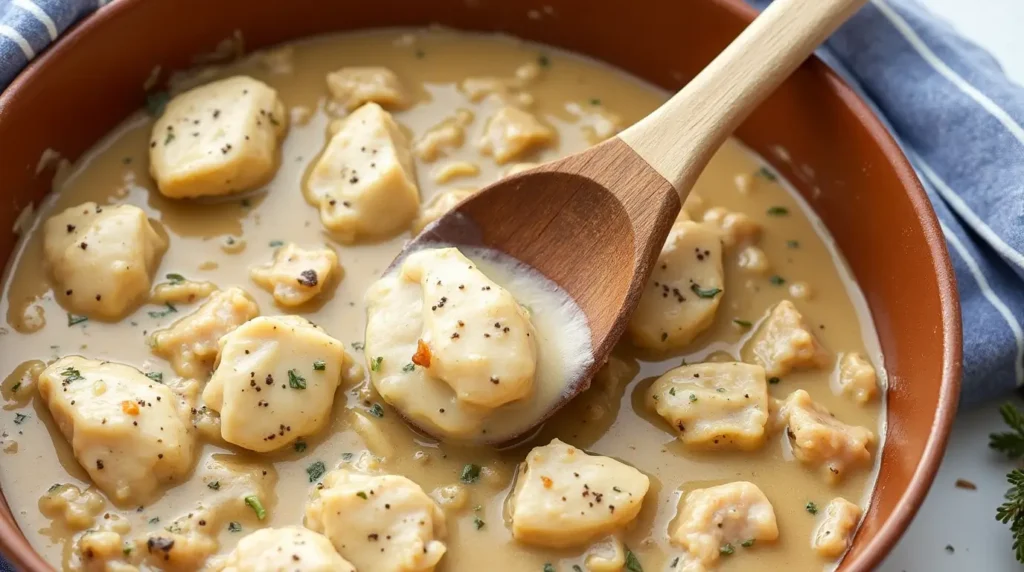
Here’s what you need for a cream-based variation:
- Replace 1 cup of chicken broth with 2% or higher milk
- Add ½ cup sour cream at the end to boost richness
- Mix in heavy cream for a silkier texture
Many home chefs now mix both styles. The process starts with a broth base and ends with cream. This creates a balanced sauce that brings together deep flavors and a luxurious feel.
These professional additions can boost either style:
- A splash of white wine adds complexity
- Better than Bouillon paste deepens chicken flavor
- Sautéed red onions and minced garlic create depth
- A dash of cayenne pepper brings subtle heat
The secret to great customization lies in small adjustments. Add new ingredients gradually and taste as you go. You can always adjust the consistency – add more liquid to thin it out or use cream, cornstarch, or arrowroot to thicken.
People with dietary restrictions need different approaches. Gluten-free versions work well with cornstarch instead of flour. Mix 2 tablespoons of cornstarch with 1 tablespoon cold water for each cup of liquid to create a perfect slurry.
Conclusion
You need only simple pantry items and techniques to make delicious chicken and gravy. Anyone can create restaurant-quality gravy at home with the right ingredients, proper temperature control, and expert stirring methods.
The recipe’s success depends on significant elements. The correct flour-to-liquid ratios, heat management, and timely seasoning make all the difference. Professional techniques like monter au beurre and progressive thickening can raise a simple Chicken and Gravy into something extraordinary.
This classic chicken and gravy recipe becomes exciting with experimentation. Each variation brings unique flavors, from herbs like thyme and rosemary to choices between cream and broth-based versions. Our website recipesnutritious.com features more amazing recipes and creative food ideas.
Note that perfect chicken and gravy requires practice. These proven techniques provide a foundation. You can avoid common pitfalls and adjust ingredients to match your priorities. This chicken and gravy recipe will soon become your signature comfort dish that impresses family and friends at every gathering.
FAQs
Q1. What’s the key to making smooth, lump-free gravy? The secret lies in temperature control and constant whisking. Start with hot liquid, add it gradually to the roux while whisking continuously, and maintain a medium-low heat throughout the cooking process.
Q2. How can I enhance the flavor of my chicken and gravy? To boost flavor, try adding a bouillon cube, onion or garlic powder, fresh herbs like thyme, or a splash of sherry. You can also use pan drippings from roasted chicken for a richer taste.
Q3. What’s the ideal flour-to-liquid ratio for perfect gravy consistency? The recommended ratio is 1.5 to 2 tablespoons each of flour and fat for every cup of liquid. This proportion ensures a smooth, well-thickened gravy without being too heavy.
Q4. Should I use chicken stock or broth for my gravy? Both can work well. Use chicken stock when you want more body and mouthfeel, and broth when you need both volume and flavor. High-quality homemade stock often provides the best results.
Q5. How can I customize my chicken and gravy recipe? Experiment with different herb combinations like thyme and rosemary, or try a cream-based version by replacing some broth with milk or cream. You can also add white wine, sautéed vegetables, or a dash of cayenne for unique flavor profiles.

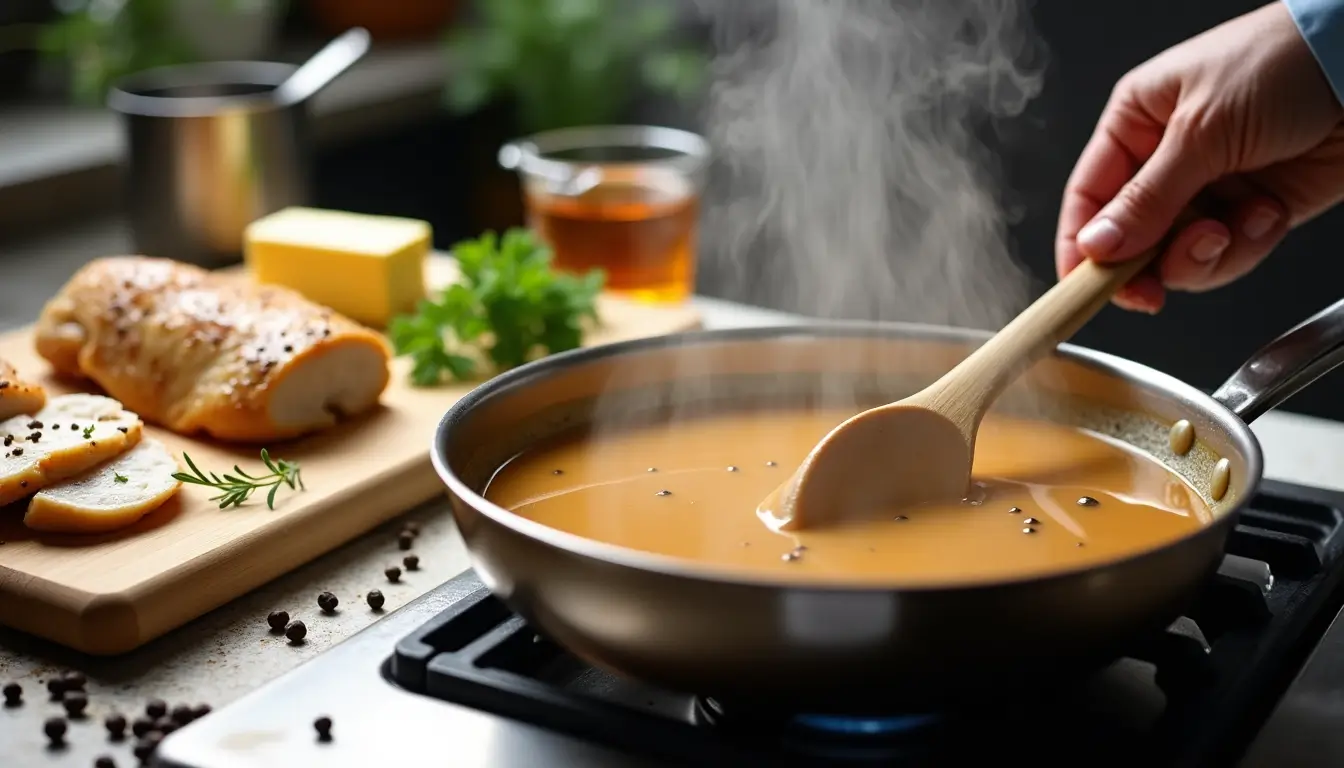
1 thought on “The Best Chicken and Gravy Recipe: Secret Tips from Home Chefs”
Comments are closed.